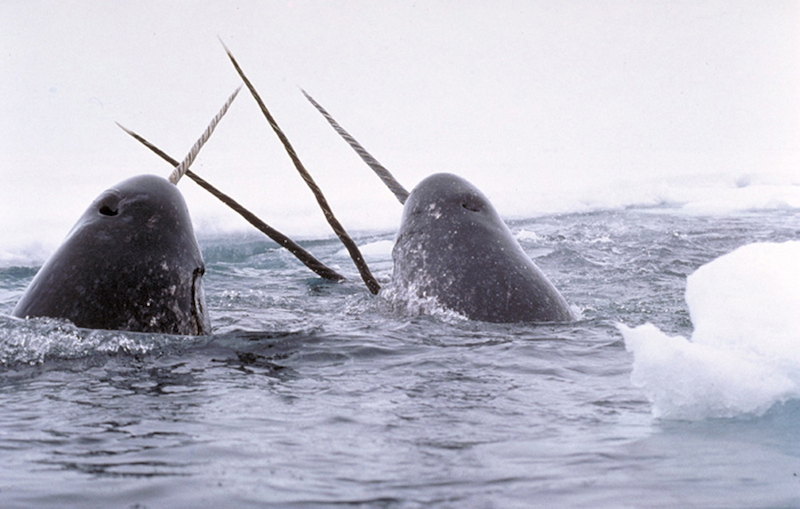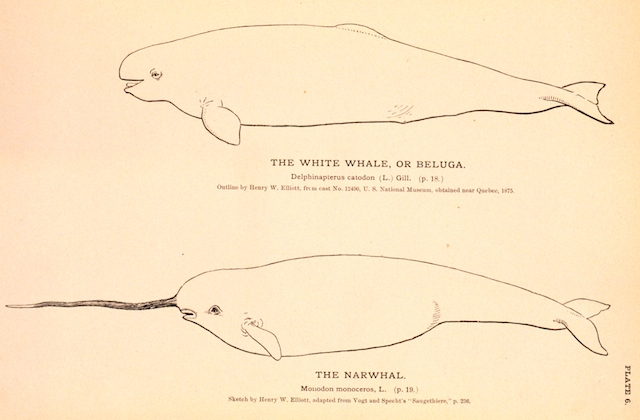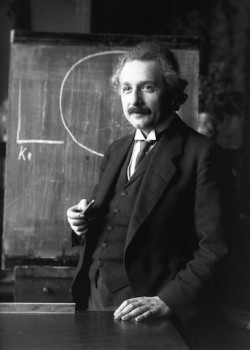
Narwhals breach the water / Photo: Glenn Williams - National Institute of Standards and Technology, Wikimedia Commons
Two new studies: Verifying Einstein’s time-dilation theory, and understanding whale testicles
University of Manitoba researchers constantly find insights into nature’s workings in places others overlook; it’s how we were the first to discover the link between breast milk and HIV transmission, the vaccine for Rh disease, canola, and inaudible squirrel calls, to name a few.
This informed imagination our researchers all possess is what led our post doctoral student Trish Kelley to wonder, do narwhals with longer tusks have bigger testicles? Yes, they do, and it has conservation implications.
The drive to uncover nature’s secrets is also what propelled physics professor Gerald Gwinner to slog through data generated by particle accelerators for 15 years. He and his colleagues imagined a better way to confirm Albert Einstein’s time-dilation theory, carefully planned a visionary experiment, and now they are basking in results that are “nearly five times better than our old result and 50 to 100 times better than any other method used by other people to measure relativistic time dilation.”
Perhaps Einstein was right when he said “Imagination is more important than knowledge.”
A whale of a tale
Narwhal tusks are a remarkable tooth, able to provide sensory information to its owner, and a new study by researchers in the Centre for Earth Observation Science (CEOS) at the University of Manitoba suggests the tusks also advertise a male’s sexual prowess: the bigger the male’s tusk, the bigger his chances of mating. The tusk is the whale equivalent of a peacock’s feathers or a stag’s antlers.
Trish Kelley, PhD, discovered the positive correlation between the appendages after examining the anatomy of 144 narwhals legally killed in Inuit subsistence hunts between 1997 and 2008. She reports the findings in the paper “Mating ecology of beluga (Delphinapterus leucas) and narwhal (Monodon monoceros) as estimated by reproductive tract metrics”, published in Marine Mammal Science.
The paper also notes that “Beluga had significantly larger testes relative to body size than narwhal, suggesting they were more promiscuous than narwhal.”
And here, in that schoolyard-funny sentence, is where conservationists get a jolt.
As CEOS adjunct professor and the study’s co-author Steven Ferguson explains, if beluga’s are more promiscuous, it suggests that they may have evolved some advanced cognition, as has been noted in other studies examining primates. If that is the case, conservation efforts must maintain the social structure and culture of the whales. Hunters, for instance, would have to proceed in a way that maintains the animal’s society. Narwhal’s, by comparison, may be less cognitively evolved: a male-dominated species where mating is determined by the male’s brawn, as advertised by his tusk. This tusk, the study found, grows larger than body size after maturity, whereas beluga testicles grow larger after maturity. As the relationship between tusk length and testes size only applies to mature males — not juveniles — it suggests it has a critical role in mating.
More study is needed, but as this study suggests, the different mating systems for narwal and beluga’s mean the two species may respond differently to climate change.’
This study is being reported by The Economist, Time and CBC’s As it Happens, among others.
Does anybody really know what time it is?
Physics professor Gerald Gwinner and his colleagues recently published an exciting paper in the journal Physical Review Letters. The paper has been getting international media attention because the team’s experiments confirm that time moves slower for a moving clock than for a stationary one.
After 15 years of work, the results are strikingly accurate.
“It is nearly five times better than our old result and 50 to 100 times better than any other method used by other people to measure relativistic time dilation,” Gwinner told the press.
“The big challenge has been really to set up the experiment properly, so avoid any systematic errors that would skew the results,” Gwinner told UM Today. “This is the most precise measurement ever carried out on an accelerator beam.”
Indeed, as Nature notes: “The researchers measured the time-dilation effect more precisely than in any previous study, including one published in 2007 by the same research group.”
From Nature:
To test the time-dilation effect, physicists need to compare two clocks — one that is stationary and one that moves. To do this, the researchers used the Experimental Storage Ring, where high-speed particles are stored and studied at the GSI Helmholtz Centre for heavy-ion research in Darmstadt, Germany.
The scientists made the moving clock by accelerating lithium ions to one-third the speed of light. Then they measured a set of transitions within the lithium as electrons hopped between various energy levels. The frequency of the transitions served as the ‘ticking’ of the clock. Transitions within lithium ions that were not moving served as the stationary clock.
…Understanding time dilation has practical implications as well, he notes. Global Positioning System (GPS) satellites are essentially clocks in orbit, and GPS software has to account for tiny time shifts when analysing navigational information.








